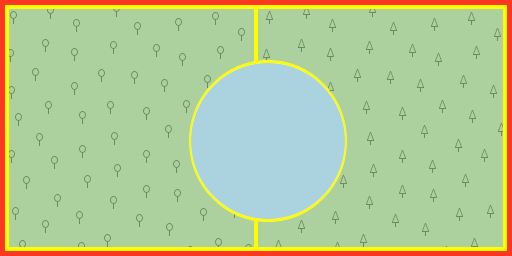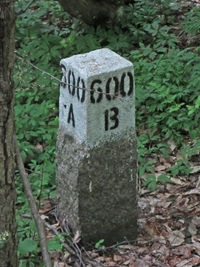Tag:boundary=forest_compartment
 |
| Description |
|---|
| A marked subdivision of delimited forest, which is used for planning, management & navigation. |
| Group: boundaries |
| Used on these elements |
| Useful combination |
|
| See also |
| Status: approved |
| Tools for this tag |
A forest compartment is a single piece of a given delimited forest, which is identified by a reference, often a number, which is unique inside the delimited forest. Forest compartments are not a land lot nor a cadastral parcel. Though boundaries of forests and their compartments on one hand, and land lots on the other hand, frequently overlap, a given delimited forest or forest compartment may be composed of multiple land lots, and a single land lot may be divided in multiple delimited forests or forest compartments. Each compartment should be modeled as a single boundary=forest_compartment entity, without consideration for any land lot boundaries which may encompass or be contained within the compartment.
These units are marked on the ground by boundary markers (painted marks, signs attached to trees, posts or boundary stones) showing a unique identifier (ref) for the compartment. These markers are useful navigation aids.
How to map
There must be a 1:1 correspondence, that is to say one boundary=forest_compartment entity by compartment, and one compartment by boundary=forest_compartment entity. Consequently, boundary=forest_compartment relations should never overlap. Note that a delimited forest is not always divided into compartments.
The link between a delimited forest (boundary=forest) and its compartments is spatial, as for all boundary entities: a compartment is considered part of a delimited forest if and only if its boundary=forest_compartment entity is spatially fully encompassed by the boundary=forest entity. Do not include boundary=forest_compartment entities as ![]() subarea
subareaboundary=forest relation; such modelling is disputed and widely considered redundant.
It may happen that the compartment materialization signs only show the compartment ref, and don't allow to know to which forest the compartment belongs. It is also possible that delimited named forests don't exist in a region and, therefore, that boundary=forest is not applicable. It is thus accepted to map the boundary=forest_compartment entities without mapping the boundary=forest entity to which they belong. The enclosing boundary=forest entity should be mapped if this information is available.
A boundary=forest_compartment entity should have the following tags:
| Key | Value | Discussion |
|---|---|---|
type
|
boundary
|
Mandatory if the entity is a relation[1] |
boundary
|
forest_compartment
|
Mandatory |
ref
|
The compartment ref displayed on the ground
|
Recommended. According to the Map what's on the ground principle, this tag's value must be the one displayed on the ground. For a compartment, this must be the unique ref of the compartment within the encompassing delimited forest, not a ref which is valid in, or applies to, a broader area.
It may happen that official databases record, or local signs display, this local ref along with additional data (the ref of the surrounding forest, an owner ref…); if so, one should remove these additional details, which are not related to the compartment itself, and only keep the compartment ref inside the delimited forest, as displayed. |
name
|
A name
|
Optional. If and only if applicable, the compartment can be named with this tag. Don't confuse name and ref! A name is a word or group of words with a intrisic meaning, whereas a ref is a sequence of numbers/letters whose meaning exists only in the context of a larger delimited forest. If you want to use this tag, think twice: it is likely you're trying to tag a ref, not a name, as typical compartments have only a reference, not a name. |
As a delimited forest is managed as a whole, it is not useful to tag each compartment belonging to a delimited forest with tags applying to the whole delimited forest; such tags should be applied on the enclosing boundary=forest entity. For instance, the operator of the delimited forest is most probably unique, so an operator tag should not be applied on each compartment, only on the boundary=forest entity.
It is also necessary to map the actual areas covered by trees with landuse=forest and other areas of vegetation with appropriate tags such as natural=scrub, natural=wetland etc.
There will usually be tracks highway=track), paths, water features, and cutlines (man_made=cutline along the boundary with an occasional marker=* post, stone or plate. More rarely they might be fences (barrier=fence).
Usually it will become apparent fairly quickly what the overall scheme for compartmentalisation of any given forest might be. For instance historic forests in the former Russian Empire often have a rectangular grid based on 1 verst.
What if I encounter a natural=wood/landuse=forest (multi)polygon which in fact represents a forest compartment?
- Enclose the overall compartment in a
boundary=forest_compartmententity (area if relevant, relation otherwise) with the relevant tags (reftypically) which you may borrow from thenatural=wood/landuse=forestentity if relevant - Keep the actual
natural=wood/landuse=forestentity. Beware: it may be a duplicate of a largernatural=wood/landuse=forestentity which encloses it, leading to 2 overlappingnatural=wood/landuse=forestentities (it has been done before); if so, you will need to remove one of the entities or merge the two, depending on which action removes the overlap while not losing details such asleaf_type).
FAO Definition
Taken from Guidelines for the management of tropical forests "A compartment is a permanent, geographically recognisable unit of forest land forming the basis for planning, prescription, implementation, monitoring and recording of forest operations. ... areas of forest that are to be managed for different purposes, or have clearly different functions or values, should be placed in separately defined compartments. Wherever practicable:
- "Boundaries should be geographically recognisable, such as rivers, streams, ridges and gullies. Permanent roads and trails may also be used.
- "Compartments should as far as possible comprise uniform forest types and be physically recognisable on the ground.
- "Numbering should be sequential, usually commencing at a forest headquarters.
- "A practical size range for many management situations is between 100 and 500 hectares."
Examples
A forest compartment should be mapped as follows:
- The overall forest compartment should be mapped as an enclosing polygon or relation. Do not add land cover tagging (such as
natural=*) to this boundary or "cut out" minor non-wooded areas such as ponds or screes that may be present. - Natural features (such as
natural=wood,natural=water,natural=scree, etc.) should be separately tagged with their own polygons delimiting actual areas where these features are present, and as an inner multipolygon member of the enclosingnatural=wood/landuse=forestfeatures if they are not wooded. Woodland-specific tagging such asleaf_type=*,leaf_cycle=*, etc., should be tagged onnatural=wood/landuse=forestfeatures.

natural=wood) and the overall forest compartment entity (tagged boundary=forest_compartment); the pond is considered part of the compartment and therefore included in it.France
Large forests, particularly those also used for leisure, tend to divided into compartments based around a regular network of rides and forest roads. In the ![]() Forêt de Fontainebleau the network consists of rides radiating from certain points in the forest (carrousels). The compartment number if shown at each junction bounding the compartment.
Forêt de Fontainebleau the network consists of rides radiating from certain points in the forest (carrousels). The compartment number if shown at each junction bounding the compartment.
Poland

Polish forest data imported from often has an identifier associated with each forest compartment of the form: "02-36-1-09-20 - -" (see 228402932![]() 228402932. Only the latter two groups are used for marking compartments on the ground. The complete form is tagged with
228402932. Only the latter two groups are used for marking compartments on the ground. The complete form is tagged with adr_les=*. The leading elements represent higher level units in the national forest administration.
Example: 600A/600B, a marker post in ![]() Białowieża Forest near
Białowieża Forest near ![]() Topiło represents two square compartments half a
Topiło represents two square compartments half a ![]() verst on each side.
verst on each side.
Russia
- КЛ - колхозный лес : a collective farm forest
- СЛ - совхозный лес : state farm forest
- ГЛ - государственный лес : state forest
- ПП - пробная площадь: test area
- Example
- Line 1: 30-14,15,16 - 30 in the quarter, Mark 14,15,16
- Line 2: KM 11 - KM "Cleaning cluttering" 11- 2011
- Line 3: 2-10,2 - plot №2, an area of 10.2 hectares.
OST 56-44-80
- пример
- строка 1: 30-14,15,16 - в квартале 30, выделах 14,15,16
- строка 2: УЗ-11 - УЗ "Уборка Захламленности", 11- 2011 год
- строка 3: 2-10,2 - делянка №2, площадь 10,2 га.
ОСТ 56-44-80
Rendering
Tracestrack Topo outlines forest compartments.
Similar rendering has been requested from OpenStreetMap Carto. [1]
Related tags
The deprecated synonym boundary=forestry_compartment is used slightly less often than the tag documented here.
A compartment is often part of a larger delimited forest boundary=forest.
For the actual markers, the tag marker=* is approved (e.g. marker=post or marker=stone). In the past man_made=boundary_marker, historic=boundary_stone and signpost=forest_compartment have also been used.
A plain ref=* has been used in some places, notably Poland, and often with imported data.
See also
boundary=forestman_made=cutlineA line cut in the forest for access or a![[W]](https://upload.wikimedia.org/wikipedia/commons/thumb/0/00/Tango_style_Wikipedia_Icon_no_shadow.svg/16px-Tango_style_Wikipedia_Icon_no_shadow.svg.png) fire break. Cutlines are often on compartment boundaries.
fire break. Cutlines are often on compartment boundaries.
Other discussions
On the russian language forum, google translation to english here